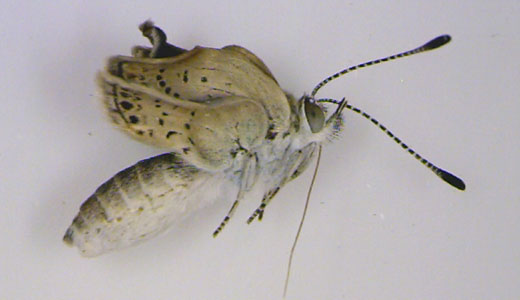
The ripple effect of the Fukushima nuclear disaster in Japan in March 2011 has still not been fully understood, but another part of the aftermath has fallen into the spotlight. Scientists there have connected abnormalities in butterflies to radioactive fallout, confirming that the Fukushima Daiichi power plant disaster caused “physiological and genetic damage to pale grass blue butterflies.”
The tracking of common butterflies around the plant began two months after the worst nuclear disaster since Chernobyl. About 121 insects were collected – 12 percent of which had peculiarly small wings. Then those irradiated butterflies had offspring, and the percentage increased. Now that number is something in the ballpark of 56 percent.
“At the time of the accident,” wrote the researchers in their study, “the populations of this species were overwintering as larvae and were externally exposed to artificial radiation. It is possible that they ate contaminated leaves during the spring, and were thus also exposed to internal radiation.”
The butterfly deformities seen included dented eyes, bent wings, malformed antennae, and abnormal color patterns.
Seventeen months after the Fukushima disaster, the word is that the effects on people have been minimal. No deaths or illnesses directly related to the accident seem to have been reported. But the long-term effects – on both people and the environment – are still unknown.
Traces of radioactive cesium, however, have been found in more than a dozen bluefin tuna caught in August 2011 in San Diego, Calif. Though the cesium levels were not considered very harmful, they still exceeded “government safety levels.” The incident was just one of many, and served as a reminder that the damage caused by the Fukushima incident is not yet done, and that it may continue to crop up in the smallest and most subtle of ways.
Amidst concern that people would begin exhibiting physiological effects from the fallout, Joji M. Otaki, the head scientist on the study, explained, “Humans are totally different from butterflies, and they should be far more resistant.” However, he suggested it remains to be seen if aftereffects will be seen in other organisms.
On the other hand, the Fukushima disaster has changed people in another way: This past July, more than 100,000 people gathered in Tokyo to protest nuclear power. The demonstration was a response to Prime Minister Yoshihiko Noda’s decision to restart two of Japan’s nuclear reactors (the other 52 remain idle).
“After the Fukushima disaster,” said protester Miho Igarashi, “I thought that the government and vested interests were telling us lies about nuclear power being safe. We have to raise our voices against the danger of atomic power.”
Meanwhile, for those who continue to argue that nuclear energy is both feasible and safe, protesters may have a new, compelling argument: “Tell that to the butterflies.”
Photo: An adult pale grass blue butterfly, collected from near the Fukushima Daiichi plant, is here shown with dented eyes and stunted wings – mutations caused by radiation. Chiyo Nohara/AP










